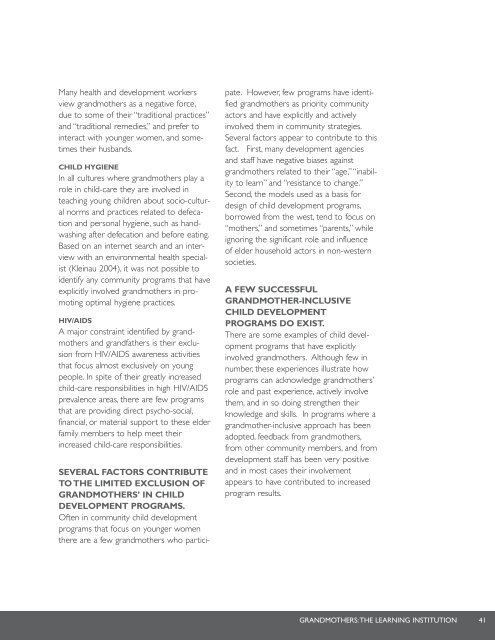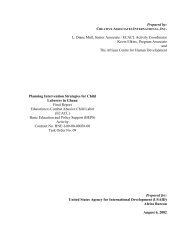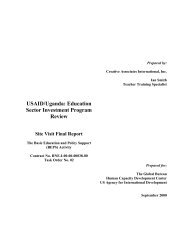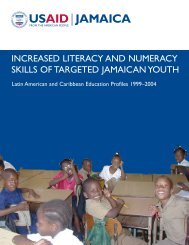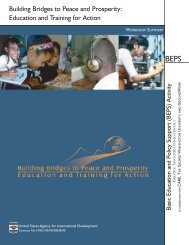Grandmothers: A Learning Institution - Basic Education and Policy ...
Grandmothers: A Learning Institution - Basic Education and Policy ...
Grandmothers: A Learning Institution - Basic Education and Policy ...
- No tags were found...
You also want an ePaper? Increase the reach of your titles
YUMPU automatically turns print PDFs into web optimized ePapers that Google loves.
Many health <strong>and</strong> development workersview gr<strong>and</strong>mothers as a negative force,due to some of their “traditional practices”<strong>and</strong> “traditional remedies,” <strong>and</strong> prefer tointeract with younger women, <strong>and</strong> sometimestheir husb<strong>and</strong>s.CHILD HYGIENEIn all cultures where gr<strong>and</strong>mothers play arole in child-care they are involved inteaching young children about socio-culturalnorms <strong>and</strong> practices related to defecation<strong>and</strong> personal hygiene, such as h<strong>and</strong>washingafter defecation <strong>and</strong> before eating.Based on an internet search <strong>and</strong> an interviewwith an environmental health specialist(Kleinau 2004), it was not possible toidentify any community programs that haveexplicitly involved gr<strong>and</strong>mothers in promotingoptimal hygiene practices.HIV/AIDSA major constraint identified by gr<strong>and</strong>mothers<strong>and</strong> gr<strong>and</strong>fathers is their exclusionfrom HIV/AIDS awareness activitiesthat focus almost exclusively on youngpeople. In spite of their greatly increasedchild-care responsibilities in high HIV/AIDSprevalence areas, there are few programsthat are providing direct psycho-social,financial, or material support to these elderfamily members to help meet theirincreased child-care responsibilities.SEVERAL FACTORS CONTRIBUTETO THE LIMITED EXCLUSION OFGRANDMOTHERS’ IN CHILDDEVELOPMENT PROGRAMS.Often in community child developmentprograms that focus on younger womenthere are a few gr<strong>and</strong>mothers who participate.However, few programs have identifiedgr<strong>and</strong>mothers as priority communityactors <strong>and</strong> have explicitly <strong>and</strong> activelyinvolved them in community strategies.Several factors appear to contribute to thisfact. First, many development agencies<strong>and</strong> staff have negative biases againstgr<strong>and</strong>mothers related to their “age,” “inabilityto learn” <strong>and</strong> “resistance to change.”Second, the models used as a basis fordesign of child development programs,borrowed from the west, tend to focus on“mothers,” <strong>and</strong> sometimes “parents,” whileignoring the significant role <strong>and</strong> influenceof elder household actors in non-westernsocieties.A FEW SUCCESSFULGRANDMOTHER-INCLUSIVECHILD DEVELOPMENTPROGRAMS DO EXIST.There are some examples of child developmentprograms that have explicitlyinvolved gr<strong>and</strong>mothers. Although few innumber, these experiences illustrate howprograms can acknowledge gr<strong>and</strong>mothers’role <strong>and</strong> past experience, actively involvethem, <strong>and</strong> in so doing strengthen theirknowledge <strong>and</strong> skills. In programs where agr<strong>and</strong>mother-inclusive approach has beenadopted, feedback from gr<strong>and</strong>mothers,from other community members, <strong>and</strong> fromdevelopment staff has been very positive<strong>and</strong> in most cases their involvementappears to have contributed to increasedprogram results.GRANDMOTHERS:THE LEARNING INSTITUTION41


